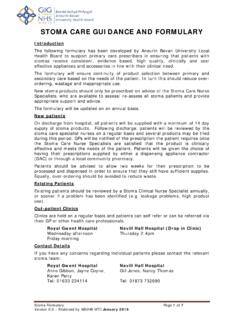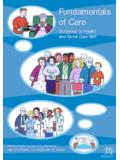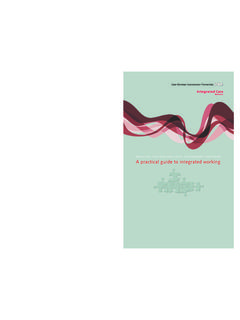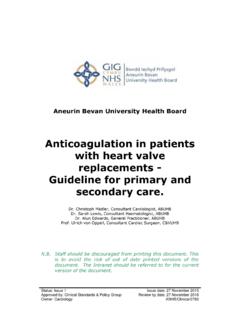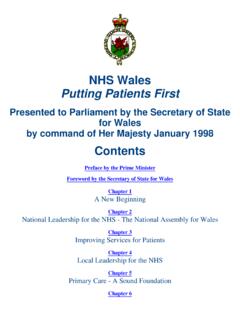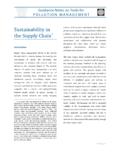Transcription of What is the ARC Centre? - Health in Wales
1 what is the ARC Centre? Main elevationCourtesy of Stride Treglown and Mike GoveRCis an acronym for Assisted Recovery in theCommunity. So what is the ARC Centre? In an innovative and distinctive buildingsupporting the Abertawe Bro Morgannwg UniversityHealth Board s and ARC s progressive model for mentalhealth care delivery. The building provides a service to helplocal adults with mental Health issues by providingstructured support and activities that are based in the widercommunity. These range from social and leisure activities toeducation, employment and skills for daily s work is frequently praised and received aprestigious NHS Wales Award 2008 in the Citizens at theCentre of Service Design and Deliverycategory. Withsupport from the Welsh Assembly Government, the ARCteam moved into its new purpose-built facility inDecember 2009. Whilst the building symbolises ARC, it is no more than abase from which most of the real work with service users isdone in the community.
2 To properly comprehend thesignificance of the ARC centre we need to understand whatpreceded it and the seismic shift in care policy which hasshaped today s progressive ethos. This is entirely centred onthe individual service user s needs and for people with mental Health problems inBridgend had previously been provided in three largePsychiatric Hospitals. Following the 1989 All Wales MentalHealth Strategy Parc and Penyfai Hospitals were closed(1994, 1995).Day care opportunities for people with mental healthproblems, many of whom had been resettled into thecommunity, were provided through separate agencies andlacked coordination. Activities that were offered primarilythrough Cam Cyntaf at Glanrhyd and Ty r Ardd atSunnyside were often duplicated, lacked a communityfocus and engendered a culture of dependence from in-patient to day care. This failed to promote either wellbeing or recovery. The day services were unattractive for youngerindividuals experiencing first episodes of mental illness andlacked flexibility and choice.
3 Moreover they fostered aculture of of Stride Treglown and Mike GoveInternet: the strategy shifted The Joint Mental Health Strategy Planning Team (JMHSPT),which included service user and carer representatives,commissioned a research project funded by the NuffieldFoundation to consider current services and the need todevelop employment opportunities for those using was followed in 2001 by a Joint Consultationworkshop and discussions with a wide range of partnersincluding service users, carers, staff, voluntary andstatutory services with the result that a jointly agreedmodel of Day Opportunitieswas proposed. The proposalwas further developed through a multi agency DayOpportunities Group and formed a key component of theOutline Business Case (OBC) and subsequent Full BusinessCase (FBC) for the Modernisation of mental Health (MH)services in Bridgend. Both the OBC and FBC were subject towide consultation and individuals with MH problems werefurther supported by the Voluntary Sector to respond andprovide comments on the Welsh Assembly Government approved the FBC in2006 including 2m capital to reprovide the existing daycare services into fit for purpose accommodation tosupport the new model of Day Opportunities.
4 A further 1m was also made available to support the developmentof a third sector Drop In Centre to be developed as thesecond stage of this project. It was anticipated that thiselement of the project would provide a focus for somepeople recovering from their mental illness and for othersa preventative was added to this work through the publicationof the Welsh Assembly Government Strategy for Adult MHservice for Wales in 2001 and the National ServiceFramework in opportunities The proposal set out the case for implementing newinitiatives in Day Opportunities. This would be achievedthrough deliberate partnership working and integrationproviding those who use the service with a greater rangeof meaningful activities in the wider community. It wouldachieve this by opening up access and supportingindividuals to make informed choices according to theirindividual level of need, promoting recovery andnormalisation, whilst reducing dependence and integration of existing statutory services wouldcreate opportunities to connect with a wide range oforganisations and expand access to services with newopportunities arising beyond the traditional and limitedboundaries of public sector MH the plannA Joint Advisory Board (JAB) was established tostrategically manage the integration of the twoservices and oversee the financial, resource andgovernance implications of bringing together healthand social care services.
5 The JAB was also responsiblefor developing a Section 33 Agreement to poolbudgets with the local authority being the leadorganisation responsible for the new was recognised that the proposed changes wouldrequire a lead individual to provide effective strategicleadership and to coordinate the implementation ofthe plan on a day to day basis. In 2004 the localauthority secured grant funding to appoint a JointDay Opportunities Coordinator and this was followedby the appointment of a Joint Operational Manager(jointly funded by Health and social services).nNumerous ongoing workshops and individualconsultations took place throughout the process ofchange with both Service Users and staff. nTaster sessions at Ty r Ardd were provided and agraduated process of integrating the services andservice users followed, ensuring each individual wastreated with respect and their individual needs wererecognised and Patients Council and Trust Patient ExperienceFacilitator provided support to the service users atCam Cyntaf around the changes.
6 The Service Userforum provided support to Service Users at Ty r was agreed that Cam Cyntaf should close and thatTy r Ardd would become the temporary base for thenew service. A plan was developed with staff andservice users resulting in the eventual closure of CamCyntaf in July 2006 and the full integration of bothstaff and service users into one building under a newmodel of deliberate culture of openness underpinned thewhole process of service user representativeprovided input to the Modernisation CommunicationGroup and regular newsletters were provided to staff,service users, carers and the wider JMHSPT had long recognised the need for aService User and Carer Participation officer to supportindividuals in the planning and delivery of servicesand through strategic changes. In 2006 this post wasdeveloped through Welsh Assembly Governmentfunding to further enhance the representation ofService Users and carers in assisting the developmentof process of change was also a significant challengeand cultural change for staff and the integration ofhealth and social care staff was achieved through fullinvolvement in workshops, training, individualcounselling and joint working with human resourceservices and staff side representation from Section 33 Agreement was signed in October 2008with a Pooled Fund Manager identified andgovernance arrangements through a PartnershipManagement.
7 Approval was obtained for the new serviceto be based on Quarella Road adjacent to the towncentre and the new facility was completed inDecember new service base provides resources for numerousstatutory and voluntary sector groups and acts as agateway to the community for people recoveringfrom periods of mental ill modelThe new service emphasises the need to view day timeopportunities as a means to an end rather than an end initself, enabling individuals to use existing communityfacilities as any other member of the public or to usespecialist services according to assessed need. Having theopportunity to move between services and to move onthrough and hopefully out of services, enhances quality oflife, as well as promoting service is targeted at those individuals who havebeen assessed as part of the Care Programme Approach(CPA) to require the service. Referrals to Day Opportunitiesare received from Community MH Teams, Crisis Resolutionand Home Treatment services, Assertive Outreach and in-patient services.
8 The elements of the service are:An Integrated Core Assessment Teamworks in fullpartnership with the service user to undertake anassessment through the use of an Individual Profile anddevelop a plan that becomes the property of the serviceuser. The assessment focuses on the individual sachievements, coping strategies and strengths and buildson their future hopes and desires for the future ratherthan on failings. Central to the assessment and the processof recovery is the individual s story about his/herexperience of mental Implementation Teamof Support Time and RecoveryWorkers implements the programme of activity with theindividual, promoting their recovery through usingmainstream community services as far as possible andfocussing on enhancing their abilities and coping specialist interventions are available for those whoneed them to assist in their roles of employment, education and training arecrucial to the work of Day Opportunities.
9 Individuals aresupported to move towards independence through workrelated training projects, volunteering opportunities responseThe design response took inspiration from the words access to multiple facilities under one roof . The clientbrief was for a single storey building that had flexiblespaces. The site also had to deliver the Local Authoritiesaspiration of a gateway building to the town centre . As a result of these two key drivers, a building thatraises the profile of mental healthcare in Bridgend (andSouth Wales ) has been realised. The large inclined copperroof gives the building a height and presence thatprovides protection and shelter. The curved plan formresponds to the site geometry, pushing its public face tothe site perimeter. Despite mental healthcare issues touching many familiesthere can still be a resistance to these facilities within localcommunities. The architects consulted with the localresidents to produce a facility that was sympathetic to theadjacent housing, despite presenting a bold fa ade to allthose that pass it.
10 Neighbours were happy that the designrespected their privacy and responded to the domesticscale of surrounding properties. This is achieved by thesloping roof with large overhangs creating a building thatis metres high at the rear but over9 metres high to the distinctive form deliberately raises the profile ofmental healthcare in the community. The bold use ofmaterials and floating landmark roof set the buildingInternet: from those on Quarella Road that surround itcreating a unique and confident identity for mentalhealthcare in caf situated close to the entrance foyer reinforces thecommunity aspect of the building. The building creates a once seen never forgotten impression for both users andpassers by, this raises interest and gives ARC a wider profilein the design of the ARC Centre also takes an innovativeapproach to internal planning. Corridors are all butabolished, and as a result, almost all of the circulation areais combined into one big useable space.
